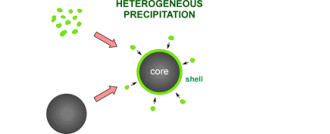

© MagnoSorb 2021

Outline
MagnoSorb deals with a sophisticated way to successfully incorporate nanotechnology in drinking water treatment and specifically for the removal of heavy metals met as high-valent ions such as chromium, selenium and molybdenum. In particular, MagnoSorb attempts to introduce a novel class of adsorbents engineered in the nanoscale but realized in kilogram-scale production rates consisting of spherical core-shell nanoparticles with a magnetically-responding phase in the inner part covered by a thin layer of the adsorption-active phase.
Motivation
An obvious advantage of nanoparticles in water treatment is their small size and consequently their elevated specific surface area which provides high reactivity, uptake capacity and, therefore, lower quantities of used adsorbents and solid wastes the challenge for MagnoSorb is to introduce a competitive solution for the serious problem of drinking water pollution with high-valent heavy metals such as chromium, selenium and molybdenum, by engineering multi-phase nanoparticles with higher efficiency than existing adsorbents but also with much lower cost as defined by the value of building phases, the application scheme and a feasible recycling plan.
Synthesis of core-shell
nanocomposite
Preparation of core-shell architecture in three steps: (i) preparation of spherical Fe 3 O 4 nanoparticles, (ii) heterogeneous precipitation of Sn 6 O 4 (OH) 4 on the magnetic seeds and (iii) modification by ion- exchange with electrolytes.Design of water treatment
setup
A contact reactor with a high enough retention time to allow adequate contact between the polluted water and the nanoparticles, and a magnetic separator installed in the outflow tube of the contact reactor.Environmental impact and
regeneration plan
Effect of particle size, shape and composition will be studied upon exposure to aquatic organisms. Leaching rate of saturated nanoadsorbents will be tested for various environments. Development of a regeneration method



The research project was supported by the Hellenic Foundation for
Research and Innovation (H.F.R.I.) under the “2nd Call for H.F.R.I. Research
Projects to support Post-Doctoral Researchers” (Project Number: 00046).





© MagnoSorb 2021
Outline
MagnoSorb deals with a sophisticated way to successfully incorporate nanotechnology in drinking water treatment and specifically for the removal of heavy metals met as high-valent ions such as chromium, selenium and molybdenum. In particular, MagnoSorb attempts to introduce a novel class of adsorbents engineered in the nanoscale but realized in kilogram-scale production rates consisting of spherical core-shell nanoparticles with a magnetically-responding phase in the inner part covered by a thin layer of the adsorption-active phase.
Motivation
An obvious advantage of nanoparticles in water treatment is their small size and consequently their elevated specific surface area which provides high reactivity, uptake capacity and, therefore, lower quantities of used adsorbents and solid wastes the challenge for MagnoSorb is to introduce a competitive solution for the serious problem of drinking water pollution with high-valent heavy metals such as chromium, selenium and molybdenum, by engineering multi-phase nanoparticles with higher efficiency than existing adsorbents but also with much lower cost as defined by the value of building phases, the application scheme and a feasible recycling plan.
Synthesis of core-shell nanocomposite
Preparation of core-shell architecture in three steps: (i) preparation of spherical Fe 3 O 4 nanoparticles, (ii) heterogeneous precipitation of Sn 6 O 4 (OH) 4 on the magnetic seeds and (iii) modification by ion-exchange with electrolytes.Design of water treatment setup
A contact reactor with a high enough retention time to allow adequate contact between the polluted water and the nanoparticles, and a magnetic separator installed in the outflow tube of the contact reactor.Environmental impact and regeneration
plan
Effect of particle size, shape and composition will be studied upon exposure to aquatic organisms. Leaching rate of saturated nanoadsorbents will be tested for various environments. Development of a regeneration method



The research project was supported by the Hellenic Foundation for
Research and Innovation (H.F.R.I.) under the “2nd Call for H.F.R.I. Research
Projects to support Post-Doctoral Researchers” (Project Number: 00046).










































































